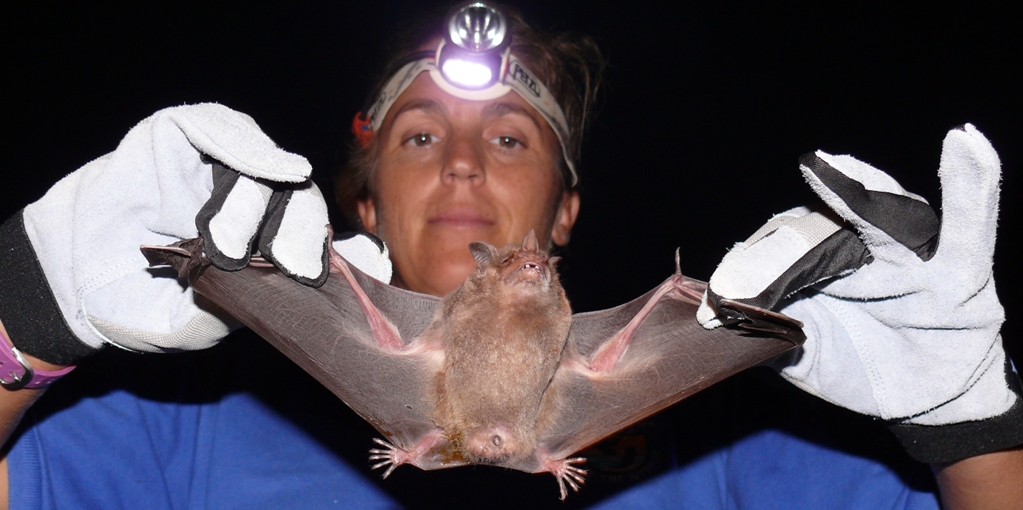
The old rum factory is home to the largest known colony of bats on St. Croix, said Jennifer Valiulis, a wildlife biologist from the V.I. Division of Fish and Wildlife.
Bats are the only mammals native to the Virgin Islands, she said. The mice, rats, deer and mongoose (and people) all came to the islands much later—when bats had already been here hundreds of thousands, if not millions of years. Bats first evolved about 50 million years ago, long before people. While some think they are flying rodents, they are not related to rodents. And though they are a mammalian order of their own, they are actually more closely related to primates like monkeys, lemurs and people.
There are five types of bats known in the Virgin Islands. The Jamaican fruit bat is the most common.
"About 70 percent of the bats we capture are Jamaican fruit bats," Valiulis said. These are big bats, with wingspans of up to 18 inches. They eat a lot of mango and other seasonal fruit. About as large is the Antillean fruit bat, which is native to Puerto Rico and the Lesser Antilles. This one likes to roost in caves and stone crevices, and so is also known as the cave bat. They make a lot of noise, and if you hear bats making a shrill, squeaking racket, you are probably hearing cave bats.
A third species of fruit-eating bat, the red fig-eating bat, is very rare and has only been found once. It seems to prefer forested, undeveloped areas and isnative only to Puerto Rico and the Virgin Islands.
In the territory, fruit bats play a major role in dispersing the seeds of native trees, like guavaberry, and in pollinating mangos, bananas, coconuts, soursop and almonds.
Another important local bat is the Pallas’ Mastiff Bat, also called the roof bat or mosquito bat. Despite the impressive sounding name, this fellow is the territory’s smallest bat, measuring only about two-and-a-half inches long and a wingspan of less than a foot. It happily lives in the eaves and attics of houses.
"If you just have even three or four roof bats around your yard, they are getting rid of two thousand or more mosquitoes a night," Valiulis said. They take well to bat houses, too, so if they are in your eaves or attic, you may be able to lure them out by setting up one of these structures – something like a large bird house. Keeping them around may help keep the bugs off of you.
Bats come out at different times of the evening. Mosquito bats come out near dusk, when the most bugs are out. The fruit bats come out later.
Lastly, there is the greater bulldog bat, also called the fishing bat. This big fellow, with a wingspan of up to two feet, flies above water using its sonar to look for fish, which it detects through tiny ripples in the water surface. It has big feet it uses to catch fish while in flight. While not seen often on St. Croix, they can be seen regularly after dusk on St. John at Cruz Bay Dock, Valiulis said.
Several wildlife biologists set up a bat-catching net and retrieved mosquito bats, cave bats and Jamaican fruit bats while Valiulis spoke. After showing them to the small crowd, they released them and they flew off, nearly silently.
There are lots of myths about bats, Valiulis said. Of 1,100 species, there are three types of vampire bats—all of which are basically harmless to people and live exclusively in Central and South America. No vampire bats are in the Virgin Islands.
There is no rabies in the Virgin Islands, so bats here do not carry it. Bats have good eyesight and excellent echo-location or sonar, so they do not get tangled in people’s hair.
"And bats are not ugly," she said while holding a Jamaican fruit bat. "See, they’re cute."
There was some disagreement in the audience about this last point.
If you have bats roosting in your house and want to get them out, do not plug the hole up yourself during the day, as the bats are probably roosting inside. If you do, you may drive them into your house, or end up with dead bats in your roof.
If you know of a bat roost, call the Division of Fish and Wildlife at 775-6762.